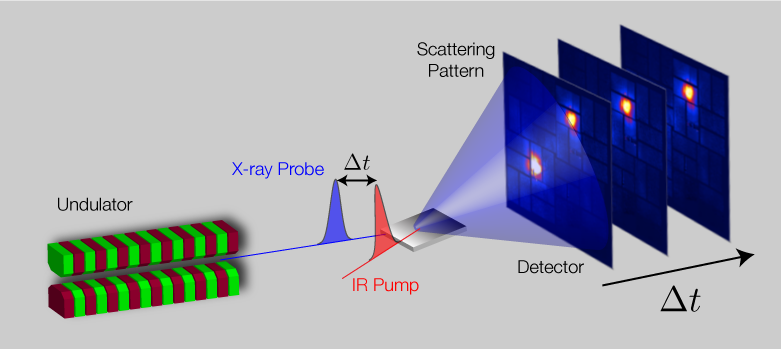Ultrafast X-ray Diffraction
The imaging of the dynamics of atoms requires a probe with Angstrom (10-10 m) wavelength and femtosecond temporal duration (10-15 s). Typical optical laser systems are readily able to generate ultrashort pulses of femtosecond duration, but lack the required spatial resolution. 3rd generation synchrotron sources have proven the capability of X-rays to image atomic structures, however only in static measurements due to their long pulse durations. Only with the advent of XFELs, probes with simultaneous temporal and spatial resolution on the atomic scale have become available and thus a whole new field of research has become accessible. However, there are only a few XFELs worldwide due to their substantial requirements in size and cost.

The figure shows a schematic of a typical pump-probe setup for a ultrafast measurement. A (typically) optical or IR pump excites a process and the dynamics of the sample is then observed by a time-delayed X-ray pulse. The combination of measurements at varying delays allows the reconstruct the dynamics in a stroboscopic fashion. The temporal resolution of this technique is given by the duration of the X-ray pulse and the jitter between the pump and the probe.
Our group is developing a significantly more compact and cheaper X-ray source that is perfectly suited as a tool to investigate ultrafast atomic dynamics. This novel laser-driven X-ray source will push the ultrafast measurement frontier: its ultrashort pulses in combination with the inherently perfect synchronization with the driver laser allows them to probe dynamics with temporal resolutions that cannot be reached even by state of the art XFELs.
A typical measurement is performed in a so-called pump-probe geometry where a reaction in a sample is triggered (pumped) by a (often) optical laser pulse and its evolution is probed with a time-delayed X-ray pulse. By varying the delay, such stroboscopic measurements result in femtosecond motion picturesor “movies” of the triggered process. The spatial dimensions are usually inferred from the measurement of the reciprocal space through diffraction.
The ultrashort pulse duration is of importance as the timescale of fundamental non-equilibrium processes such as electron transfer in molecules, intermediate states in chemical reactions, vibration dynamics (phonons) or the coupling between crystal degrees of freedom (spin, charge, lattice) in solid state systems exhibit ultrafast behavior in the few tens of femtosecond range. It therefore allows to observe the "dance" of the atoms in real time and so gives us insights into material properties and its functions as well as fundamentally important processes. A few expamples are the folding of proteins, the path of chemical reactions, photosynthesis, thermoelectricity, or superconductivity.
Relevant Publications
- Direct measurement of time-dependent density-density correlations in a solid
submitted - Below gap optical absorption in GaAs driven by intense, single-cycle coherent transition radiation
submitted